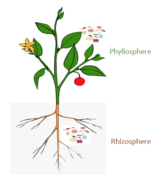
| Part of a series on |
| Microbiomes |
|---|
 |
Microbial symbiosis in marine animals was not discovered until 1981.[3] In the time following, symbiotic relationships between marine invertebrates and chemoautotrophic bacteria have been found in a variety of ecosystems, ranging from shallow coastal waters to deep-sea hydrothermal vents. Symbiosis is a way for marine organisms to find creative ways to survive in a very dynamic environment. They are different in relation to how dependent the organisms are on each other or how they are associated. It is also considered a selective force behind evolution in some scientific aspects. The symbiotic relationships of organisms has the ability to change behavior, morphology and metabolic pathways. With increased recognition and research, new terminology also arises, such as holobiont, which the relationship between a host and its symbionts as one grouping.[4] Many scientists will look at the hologenome, which is the combined genetic information of the host and its symbionts. These terms are more commonly used to describe microbial symbionts.
The type of marine animal vary greatly, for example, sponges, sea squirts, corals, worms, and algae all host a variety of unique symbionts.[5] Each symbiotic relationship displays a unique ecological niche, which in turn can lead to entirely new species of host species and symbiont.[3]
It is particularly interesting that it took so long to discover the marine microbial symbiosis because nearly every surface submerged in the oceans becomes covered with biofilm,[6] including a large number of living organisms. Many marine organisms display symbiotic relationships with microbes. Epibiotic bacteria have been found to live on crustacean larvae and protect them from fungal infections.[6] Other microbes in deep-sea vents have been found to prevent the settlement of barnacles and tunicate larvae.[6]
- ^ Faust K and Raes J (2012) "Microbial interactions: From networks to models". Nat Rev Microbiol, 10: 538–550. doi:10.1038/nrmicro2832.
- ^ Krabberød, A.K., Bjorbækmo, M.F., Shalchian-Tabrizi, K. and Logares, R. (2017) "Exploring the oceanic microeukaryotic interactome with metaomics approaches". Aquatic Microbial Ecology, 79(1): 1–12. doi:10.3354/ame01811.
 Material was copied from this source, which is available under a Creative Commons Attribution 4.0 International License.
Material was copied from this source, which is available under a Creative Commons Attribution 4.0 International License.
- ^ a b Cavanaugh CM (February 1994). "Microbial Symbiosis: Patterns of Diversity in the Marine Environment". American Zoologist. 34 (1): 79–89. doi:10.1093/icb/34.1.79. JSTOR 3883820.
- ^ Egan S, Gardiner M (2016). "Microbial Dysbiosis: Rethinking Disease in Marine Ecosystems". Frontiers in Microbiology. 7: 991. doi:10.3389/fmicb.2016.00991. PMC 4914501. PMID 27446031.
- ^ Li Z (April 2009). "Advances in marine microbial symbionts in the china sea and related pharmaceutical metabolites". Marine Drugs. 7 (2): 113–29. doi:10.3390/md7020113. PMC 2707038. PMID 19597576.
- ^ a b c Armstrong E, Yan L, Boyd KG, Wright PC, Burgess JG (October 2001). "The symbiotic role of marine microbes on living surfaces". Hydrobiologia. 461 (1–3): 37–40. doi:10.1023/A:1012756913566. S2CID 33165122.